Contents
Ornamental cabbage is a unique decoration for any site. It is often used by landscape designers in the implementation of their most daring projects. There are many varieties of this vegetable. All of them differ in plant height, leaf color and shape. Growing and caring for ornamental cabbage is not at all difficult, so it can be a real boon for beginners. You can learn in detail about growing and caring for ornamental cabbage, as well as see photos of various varieties of this amazing crop in the article below.
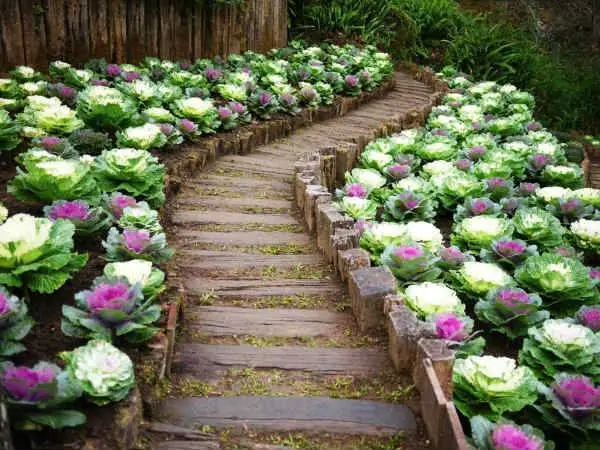
Variety of varieties
Ornamental cabbage has been known to man since IV AD. e. Already at that time, she attracted the attention of admirers of natural beauty. Today, various breeding companies are engaged in breeding and obtaining new varieties of this vegetable. Farmers are offered a huge varietal variety of ornamental cabbage, which includes improved varieties with a spreading rosette resembling a palm tree, and beautiful, primordially decorative varieties with a closed, classic rosette, rounded shape.
Palm varieties
More than half a century ago, domestic breeders bred a number of fodder varieties of cabbage, which have been improved over time and are currently used to decorate flower beds, lawns, and gardens. As a rule, such plants are quite tall, have several long petioles and curly leaves.
Lark’s tongue
This cabbage is not at all like the white “relative” familiar to many. It forms the main stem with a height of 50 to 130 cm. It has a large number of petioles up to 20 cm long. The leaves of this decorative “beauty” are curly, rather large. Their color is green. The Lark’s Tongue variety is grown from early spring to late autumn. In the second half of summer, the vegetable grows and shows all its decorative qualities.
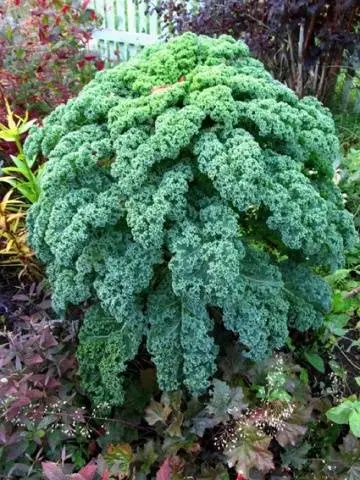
red curly
Florists and landscape designers are offered two varieties of curly cabbage. These are the varieties “High Red Curly” and “Low Red Curly”. From the name it is clear that these two species differ in plant height. Low cabbage does not exceed 60 cm in height, high grows up to 130 cm. The leaves of these varieties are sprawling. The diameter of such a plant reaches 1 m. The color of the decorative culture is dark purple.
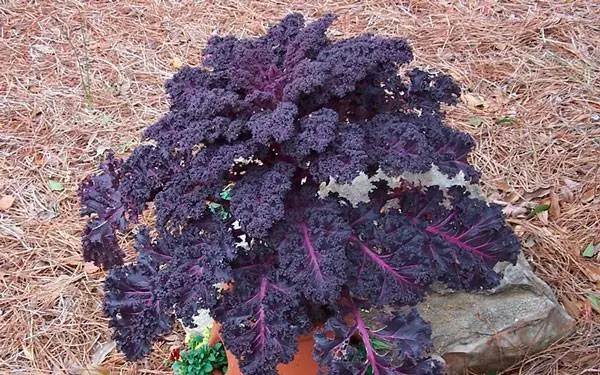
Kai and Gerda
This variety is represented by ornamental cabbage in two colors at once: green and emerald. The height of adult plants “Kai and Gerda” reaches 50 cm. Their leaves are funny, elongated in shape with curly edges. You can grow such an ornamental vegetable in a sunny area or in partial shade.

Kale red
This wonderful cabbage has not only excellent decorative effect, but also benefits for the human body. It contains 9 essential and 18 non-essential amino acids. In terms of protein, it can surpass meat. “Red kale” also contains vitamins of groups B, PP, K, C and a complex of minerals.
It is not difficult to grow such a useful cabbage on your site or flower bed. At the same time, the leaves of a beautiful, curly plant, up to 1 m high, have a pleasant, fresh, sweetish taste.

The above decorative varieties of cabbage are sprawling and massive, so they are rarely used as an independent design element. More often, such varieties in a flower bed are supplemented with other ornamental plants.
Cabbage with closed rosette
Decorative cabbage with a closed rosette looks original and interesting in a flower bed. A variety of such varieties allows you to choose a vegetable with leaves of the desired color to compose any flower arrangement.
Nagoya
This variety is highly decorative and resistant to adverse weather conditions, frost and other troubles. Cabbage leaves are arranged quite tightly, forming a beautiful “basket”. The leaf margins of the ‘Nagoya’ variety have strongly curly edges. Their color is combined: the lower leaves of an ornamental vegetable may be green in color, and the inner leaves may be red or white. Plant height up to 60 cm. You can see a photo of such an original cabbage below.
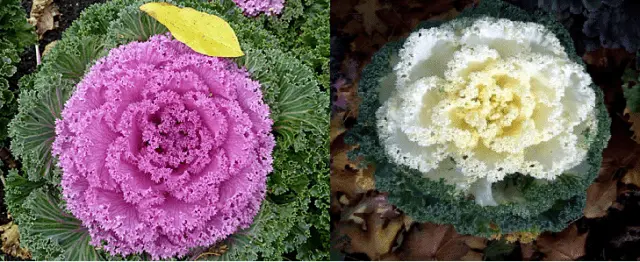
Tokyo
Cabbage variety “Tokyo” is a low plant up to 35 cm. Its leaves are rounded, with slightly curly edges. The color of the leaves is combined: the outer leaves are painted green, the inner ones can be white, red, pink. It is this ornamental cabbage that can often be seen in flowerbeds and lawns. It is used for framing tracks.
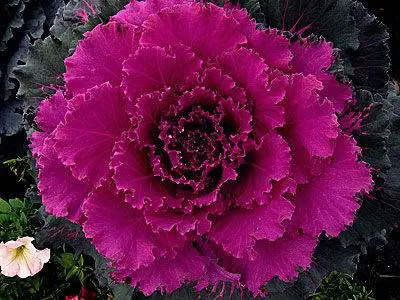
Piglon
Piglon cabbage has very interesting rosettes that look like roses. The leaves of this ornamental plant are oval with perfectly smooth edges. Their coloring combines 3 colors at once: green, cream and pink. The height of the cabbage does not exceed 30 cm. You can see such a unique plant in the photo below.
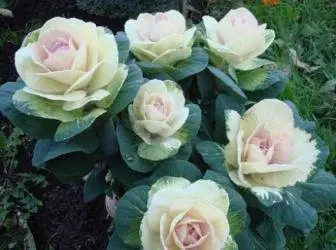
coral queen
This variety is the antipode of the “Piglon” variety: the leaves of “Coral Queen” are very dissected and look like corals. The height of such a cabbage does not exceed 20 cm, while the diameter of the rosette can reach 30 cm. The outer leaves of the ornamental vegetable are purple, the inner leaves are crimson.

In addition to the above varieties, decorative are “Osaka”, “Princess”, “Mosbakhskaya”, “Colors of the East” and some other types of cabbage. So, choosing different varieties of ornamental vegetables in height, color, leaf shape, you can create an original composition. At the same time, the Kale Red variety can become not only a unique decoration, but also a tasty, healthy treat, surprisingly for relatives and friends.
Cultivation
Ornamental cabbage is distinguished by its unpretentiousness. It tolerates frosts, lack of sunlight and transplants remarkably. The culture is grown in two ways: by sowing grains in open ground or for seedlings at home. It should be noted that cabbage acquires its decorative qualities only in the second half of summer, starting from August. That is why many farmers prefer to grow a vegetable in seedlings or in the backyards, transplanting it to a flower bed after acquiring a decorative effect.
Sowing seeds in the ground
It is recommended to sow ornamental cabbage in open ground in April – mid-May, depending on weather conditions. The sowing time of the crop should coincide with the sowing of radish seeds. Plant seeds are sown in holes at a distance of 7-10 cm from each other. The seed placement depth is not more than 1,5 cm. After sowing, the ridges should be watered and covered with polyethylene. When overgrowth appears, the protective material should be lifted onto the arcs. After a month, young plants can dive to a permanent place of growth. In some cases, ornamental cabbage is grown in the backyard before the onset of “bloom”.
Growing seedlings
The classic seedling growing method is also great for ornamental cabbages. Planting ornamental cabbage in this case begins in mid-March. Sow grains of culture in separate containers. Soil for filling containers can be prepared by mixing garden soil with sand and peat. You can remove the larvae of possible pests in the soil by heating it in an oven or by spilling a solution of potassium permanganate.
In each container filled with nutrient soil, 1 seeds should be placed to a depth of 2 cm. To maintain the best microclimate, crops should be covered with plastic wrap or glass. The temperature for cultivating seedlings must be maintained at +18-+200C. The appearance of the first shoots in favorable conditions begins after 2-3 days, after which the protective material should be removed and the containers should be installed in a room with a temperature not higher than +160C. The grown seedlings are thinned out, leaving only one of the strongest sprouts in the pot.
Watering young ornamental cabbage in pots should be as the soil dries. At the same time, increased soil moisture can provoke the development of a fungal disease – black leg. For its prevention, in addition to regular moderate watering, ash dusting of the earth is used.
Plant Care
Planting ornamental cabbage and caring for it is not particularly difficult. During the growing season, the plant can be transplanted several times to different places. So, home seedlings should be dived into open ground with the appearance of 3-4 true leaves. You can dive cabbage directly into a flower bed or into a garden bed for temporary cultivation. When planting plants, a distance between seedlings of at least 20 cm should be maintained.
The soil for growing cabbage can be any, but it is preferable to use loam and sandy loam with a high organic content. The acidity of the earth should be low. To do this, dolomite flour, slaked lime or wood ash can be added to the soil.
Ornamental cabbage is particularly demanding on moisture, so the plants in the garden should be watered regularly and plentifully, preventing the soil from drying out. The culture is also demanding for top dressing. To fertilize a vegetable, you can use organic or mineral complex fertilizers containing nitrogen, phosphorus, potassium. For the entire growing season, plants can be fertilized 3-5 times, depending on the fertility of the soil. The interval between feeding should not be less than 10 days.
You can learn some other nuances about growing ornamental cabbage by watching the video:
Pest Control
The forces devoted to growing and caring for ornamental cabbage can be wasted if pests encroach on the vegetable. These include slugs and caterpillars. In order for them not to spoil the beautiful leaves, they should be dealt with by mulching the soil with coniferous paws. Sprinkling the root plot of the earth with ash is also a preventive measure in the fight against slug.
You can scare away the caterpillar butterfly with the help of superphosphate. This substance is diluted in water in a ratio of 1:100 and used for spraying plants. This procedure must be performed every time after watering or rain.
Cabbage in a flowerpot
High decorative qualities of cabbage can be used not only to decorate flower beds and lawns, but also for windows, balconies, apartment rooms. So, cabbage can be grown in pots or flowerpots. For one plant, you need to pick up a container with a volume of 3-5 liters. Drainage holes must be made at its bottom to drain excess water. In general, growing ornamental cabbage at home is not difficult. The culture is undemanding to the abundance of light, so it can be placed away from windows.
This method of planting can also be used in open areas of the earth. The flower bed in this case will be mobile and can be transferred to different parts of the site without replanting the plants themselves.

Conclusion
Thus, the article provides a description of the most common and sought-after varieties of ornamental vegetables, as well as a detailed description of how to grow this unique crop on your site or in an apartment. After reviewing the information, the matter remains small, purchase the seeds of the variety you like and start sowing them. Soon cabbage will delight and surprise with its beauty, make the garden, vegetable garden, flower bed interesting, unique. Until the onset of severe winter frosts, a colored vegetable will remind you of a warm sunny summer.









